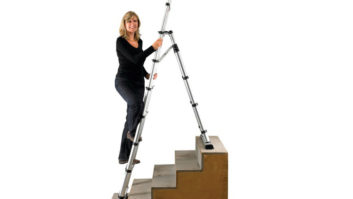No matter what field we are in, many of us want to believe that we are destined for greatness, however that is defined in our profession. Oftentimes, the measure of our success lies in our ability to come through the ranks, proving ourselves worthy at every rung of promotion, and ultimately, gaining the opportunity to guide a team through set goals.
In the custom installation business, where an installer can grow from a one-man operation to a fully staffed company within a couple of years, creating a sound business built around defined roles for employees and a hierarchy based on merit, trust, and ability can be a murky business all its own.
A lot of people who start these businesses are people who love the technology and maybe are really good at the technology, but are not necessarily backed up with a lot of business management skills, observed Ken Smith, co-owner of Custom Electronics in Falmouth, Maine. It is easy to get going, to offer something of value and to pay yourself. But the minute you start pulling in your employees and growing a business, then you really need business management skills to fall back on.
In the CI universe, Smith is an anomaly. With a business degree in his tool kit and years of experience as a career management consultant for a Fortune 50 company, he turned the training he had provided to others on himself. In pinpointing his own goals and values, Smith found his footing in the custom installation business. For many others seeking the same end result, however, the process can be littered with pitfalls and boulders.
The biggest problem is cash flow, and managing your cash, offered Ty Meyer, head of California-based Audio Video Design. There is no governing principle to it and its just a hard thing to master. It is a basic principledont spend money you dont havebut it kills us. Money has got to come in first before it can go out.
Gary Nedelisky, owner of Quadrant Systems in Bend, Oregon, caught a whiff of this truth first hand during the infancy of his company in the mid-1980s. I remember taking a class at community college and learning bookkeeping, he recalled. Well, bookkeeping was a checkbook to me. In learning about cash flow, [I saw how it] can bankrupt your company if you grow too fast. I thought it was cool to grow fast. So all of these things were new to me. And although I have a good sense of money and people, all of the managerial portions I had to learn.
For nascent custom installers taking on the challenge of creating their own firms, Nedeliskys experience isnt that unique. And with organizations such as CEDIA and CEA regularly offering courses, classes and retreats on how to better manage your company, CI entrepreneurs have a wealth of resources readily available to them.
Having the technical knowledge is obviously important but more than that, if they want to take on a bigger role or start their own firm, they have to have a solid plan of what they want, what goals they want to accomplish, and when, Meyer advised. They also have to have a vision and go to every business class and management conference and talk to as many people whove made it as possible.
The process of moving up in a company, often embodied in the phrase show and prove, is also applicable to installers who want to make strides, perhaps as a project manager or sales person, within the firm of which they are already a part.
Installers have a tendency to take the work documentation they are given and go out and do that work, observed Scott Sullivan, head of SoundVision Marin in Novato, California. The thing we are preaching to our people all the time is to know the big picture. Understand what you are doing, how that relates to what we are doing for the client, how that relates to the total project, how that relates to our business model and the services we provide, and how that relates to our companys success. That is the hardest thing we find as we try to transition someone into managementthey understand a little piece of that. I want them to understand that on every level.
Being an active participant of a companys culture is also important to Nedelisky, who often gathers everyone from installers to the head of sales at his warehouse for 7:30 a.m. meetings, and uses it as an indicator of who is actually invested in being a part of the company.
People dont think I notice things like what time they come in and what time they leave, Nedelisky said. So the guy that says to me, I want to move up, but is walking out the door everyday at one minute after four oclock says to me his life is segmented. But there all kinds of indicators for owners. Like the guy who reads the periodicals. That is the guy who is saying to me, Im educating myself about this industry. You cant do that in 40 hours, you have to have five hours a week of study, surfing the Internet. All of those things help.
Installers who want to get a leg up also need to be sure that it is really what they want to do. Smith wholly recommends what he did: take stock of key skills and set them alongside important personal goals and needs. I have taken a bunch of my employees through the course I use to teach, he said. And I would encourage them to look at their skill set. I would say to them, if they think they want this managerial role, they have to first test it against their core values. What are my responsibilities going to be in this job and does it conflict with my core values? The next thing they need to do is a skills assessment of that job. They should work with their boss within the company to figure out what the job path is through the company.
Like owners, installers can also benefit from organizational meetings, courses, and training programs provided by industry organizations and manufacturers. Meyers, Sullivan, Nedelisky, and Smith all encourage their staff to attend both national and regional events to polish up their skills and to explore aspects of the industry they might not be familiar with.
Any employee of mine that shows effort and interest, Meyer said, I make sure they go to regional education and regional training. Thats part of it too. All of the manufacturer events and the CEDIA eventsyou just cant get enough. And you need all of the help you can get. Any kind of business coaching is really good too.
With training employees to move up in the firm, however, owners often run the risk of having that employee leave the firm and become the competition, or take all their newly gained knowledge elsewhere. Smith, who is also the membership chairman for CEDIA, says it is an issue he is often presented with by concerned members. He recommends that employers form a written contract with employees either committing to a set time with the company after receiving advanced training, with a reimbursement penalty addendum should they go elsewhere before that period is up. He also offers taking a philosophical stance, should the issue arise.
You can also say, Im building or have built a company that is fun and attractive for people to work in, Smith said. You always run the risk that someone is going to take your training and move to another company. I can say unequivocally that when people have left me like that, I have replaced them with someone better.
For the most part, [my employees] havent left because they can see that I mean well for them and that I value what they do and I value them as people. My advice to business owners and managers is to say, What can I do, within my company, to make this a fun, attractive place to work. And better than where ever they think they might be able to go.
Nedelisky, who has lost a few installers to the start-up itch, says he often tries to convince employees to stay, but when that fails he sends them off with blessings. If you are going to do that, it is never easy. It is always painful, but I say try to do it with integrity, Nedelisky said. Dont steal clients, dont steal the work base, dont steal the contractors. You have been paid by this other company for all of these years to service these people, but you werent paid to steal.
As with anything worth having, stepping up the business ladderbe it venturing out as your own boss or moving from installer to project managerinvolves taking initiative, showing dedication, having a strong resolve, and stacks of common sense.
If you want to run the company, be the best installer in the company, Sullivan advised. Because if you are not the best installer in the company, and you think you can be a project manager, I doubt it. Those people who are really good, are good at everything they do.
Llanor Alleyne is managing editor of Residential Systems in New York City. Margot Douaihy also contributed to this article.






